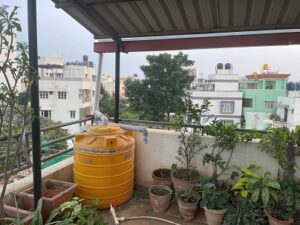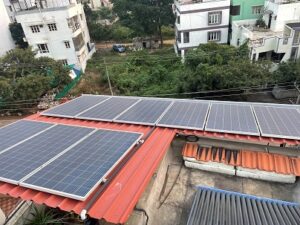Even in a city like Bengaluru, Commander Ganapathi Subramanyam, who retired from the Indian Navy in 2016, has been able to avoid the city’s waste management and water scarcity problems.
How?
When he and his family relocated to their new home after his retirement, he decided to follow sustainable practices to lead a simpler life. His new house has a rainwater harvesting system, greywater harvester, solar panels and bio-compost.
Here’s how Ganapathi made his dream sustainable home.
Rainwater Harvesting System
Bengaluru has an average rainfall of 1,000 mm, from which almost 75,000 litres of water can be collected.
For a home like Ganapathi’s, which has four members living in it, consumption might reach upto 500 litres a day. So he constructed a rainwater harvesting system that can store water for almost five months, while the rest is taken care of by borewells.
The system consists of a pump to carry rainwater from the terrace, a tank to store it, and a filter. He received government aid for this set up, so the mechanism cost less than Rs 10,000.

Greywater Harvesting System
This system involves the filtering of and reusing grey water. In order to carry this out, there must be separate pipes for both sewage and grey water. The water is collected in drums and filtered, and taken to an overhead tank.
Ganapathi says the family generates around 150 litres of grey water per day, which is used for gardening and flushing purposes. This reduces the use of harvested rainwater and makes it last for another month.
Similar to the RWH system, grey water harvesters also need an investment of less than Rs 10,000.
Solar Panels
A solar rooftop photovoltaic system has been installed to convert solar energy into electricity. One kilowatt panels are mounted on the rooftop, which not only generate electricity but also keep the house cool. The investment is around Rs 1,00,000.
So even if the whole city is experiencing power failure, Ganapathi’s home remains well-lit.
“Since the installation of the plant, there has never been a day without electricity at our home,” he says.

Credits: Ganapathi Subramanyam
Bio-compost
“The only two investments required to install a compost are will and motivation,” says Ganapathi about bio-compost. All kitchen waste is stored with some dry leaves or cocopeat, which turns into excellent manure within a few months.
Ganapathi’s wife has green fingers and has set up a garden with around 150 pots on the terrace. The manure for her plants comes from the compost.
Sustainable lifestyle
Ganapathi often shares tips and tricks of setting up a sustainable home with his neighbours and friends, he says. Some of them even visit his place to understand how the whole house works. Moreover, he’s part of a group named ‘Bangalore Water Warriors.’ Before the pandemic, he used to visit schools to introduce kids to ideas of sustainability.
Ganapathi is of the opinion that this pandemic is a chance to invest our time and energy in something fruitful for the planet. “All of us are mostly stuck at home, and a decision to invest our time and money in sustainable living will have a huge impact on the environment,” he says.
“We are well aware of global climate change and try in every possible way to reduce our share of carbon footprint,” he adds.
This ex-serviceman’s house model can be implemented at any 30*40 site construction, he says. He says it is the ideal way of leading a life without power failure and water scarcity, and most importantly, saves the planet from depletion of resources, allowing us to conserve what’s needed for the future.
No comments:
Post a Comment